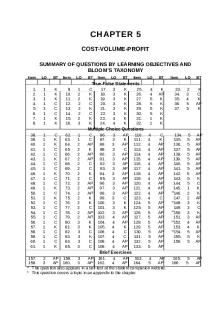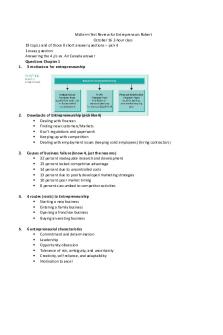Test X 2020, answers PDF

| Title | Test X 2020, answers |
|---|---|
| Course | Astronomy I Our Place in the Cosmos |
| Institution | Wilfrid Laurier University |
| Pages | 5 |
| File Size | 73.7 KB |
| File Type | |
| Total Downloads | 50 |
| Total Views | 148 |
Summary
Download Test X 2020, answers PDF
Description
The Age of our Solar system is approximately -4.6 billion years As of now most known extrasolar planets have been discovered by - Doppler technique Which of the following is not a characteristic of the moons of the solar system planets - all of the eight classical planets have at least one moon Which of the following statements about asteroids is not true - no asteroids have been found beyond the asteroid belt What is a comet - the nucleus of a comet is a collection of various ices mixed with dust and tiny bits fo rocky debris Atmospheres formed around some terrestrial planets because - outgassing through volcanic activity Which of the following solar system moons were likely formed through the same processes as our solar system - jupiter’s so called Galilean moons what was the ice or frost line of the solar system - between present day rbits of mars and Jupiter which of the following is not characteristic of the terrestrial planets - they have more moons than the jovian plants why haven’t we detected low mass planets close to their stars and high mass planets far from their stars - Both A and B above To date about how many extrasolar planets have been discovered - 700 what are the main constituents of the jovian planets - hydrogen and helium the first small solid grans or flakes formed in our solar system by the process of - condensation what is an extrasolar planet - a planet that orbits a star that is not our sun What is an exoplanet moon
- it is an object orbiting an exoplant at firs the suns present dat rotation seems to contradict the prediction of the nebular theory because - sun should have been roating fast when it formed, but the actual rotation is fairly slow why did the solar nebula heat up as it collapsed - as the cloud shrank, its gravitational potential energy…. Which of the following statements about the jovian planets is not true - outermost jovian planet Uranus…. Which one of the following is a characteristic of jovian planets - low average density the terrestrial planet cores contain mostly metal because - metals condensed first in the solar nebula and the rocks then accreted around them based on available data what kind of objects in our solar system do most of the known extrasolar planets resemble - jovian planets the planet closest in size to earth is - venus 51 pegasi is important because - it is the first star like our sun that was found to have a planet orbiting it which of the following is the origin of almost all the large moons around the jovian planets - they were formed by condensation and accretion in disk of gas around the planet which type of exoplanet would you expect to cause the largest Doppler shift - massive planet close to its star rank the 5 worlds in order of size from large to small - earth, venus, mars mercury moon the asteroid belt is found where - mars and Jupiter according to our theory of solar system formation what is pluto - one of the largetst Kuiper belt objects
the nebular theory of the formation of the solar system successfully predicts all but one of the following, which one does the theory not predict - the equal number of terrestrial and jovian planets which fo the following statements about meteroites is true - A. a metreorite si whats left of a meteor when it hits the earth’s surface which detection technique has been used to find orbital dsitnace - Doppler technique how much of the solar nebula consisted of eleemnets heavier than hydron and helium 2% which of the following statements is not an observed pattern of motion in our solar system - most planets orbit at the same speed what is the origin of the atoms of hydrogen, oxygen, and sodium in the persipartion that exits your body during this astrononoky test - hydrogen nuclei were produced a few monutes after the big bang event 13.7 billion years ago ….. which of the following is not a technique that could be used to discover extrasolar planet - direct binocular why does the solar nebul;a theory preict that planetary systems are common - all of the other answers why are the inner plantes made of denser materials than the outer planets - in the inner part of the nebula only metals and rocks were able to condense bcause of the high temperatures whereas hydeogen compounds alghouth more abundtant wer only able to condense in the cooler outer regions which of the following statements about comets is not true - the nucleus ofa comet is quite large about 100 km across which of the following is not a characteristic of the general layout of the solar system - all planets rotate on their polar axes at about the same rate according to our theory of solar system formation what is the origin of asteroids and comets - asteroids are the leftover planetsiamls of the inner solar system and comets are the leftover planetsiamsl that formed beyond the freost line
1. Our solar system contains eight major planets whose orbital characteristics are: all planets orbit in the same direction and in the same orbital plane (more or less) 2. The rotation (daily spin) of the planets are: all in the same direction (with the exception of Venus and Uranus) 3. When we think of the types of planets we notice the following: there are two types of planets: terrestrial and jovian 4. The terrestrial planets have the following characteristics: they are relatively small, high density objects with solid surfaces 5. The jovian planets have the following characteristics: they are relatively large, low density objects with no solid surfaces 6. The number of moons throughout the solar system has the following characteristic: the inner planets have very few moons whereas the jovian planets seem to have acquired many moons 7. Ring systems around planets are: all jovian planets have ring systems 8. The age of the solar system is about: 4.6 billion years 9. Comets are rocky snowballs with the following characteristics: small nucleus (3-7 km in diameter) that develop debris tails as they get close to the Sun 10.Which of the following statements about asteroids is false?: an asteroid that get’s through the Earth’s atmosphere is called a shooting star 1. Which of the following elements were not originally present in the universe?: oxygen 2. How does the solar nebula theory explain why the planets all orbit in a plane?: the planets formed in a flat disk of material around the sun 3. Using table 12.2 in the textbook or these notes, what material(s) would you expect to condense out of the Solar Nebula at the distance of the Earth from the Sun: two of the above (metal oxides or silicates or water ice) 4. Using table 12.2 in the textbook or these notes, what material(s) would you expect to condense out of the Solar Nebula at the distance of the Jupiter from the Sun: all of the above (metal oxides, silicates, water ice, two of the above) 5. What is a planetesimal?: a small building block of planets 6. What is one reason the Jovian planets were able to grow more massive than the terrestrial planets?: planetesimals beyond the ice line could accrete more kinds of solid material 7. What role did the solar wind play in the formation of the planets?: it blew away any leftover gas and dust that could be accreted by the planets 8. Which of the following is most likely to describe a comet, but not an asteroid?: mainly composed of ice and snow 9. What is a key difference between the moons of terrestrial and Jovian planets?: most of the Jovian moons were formed in a disk around each planet 10.Which of the following describes the most popular hypothesis for the formation of the Earth's Moon?: the moon accreted from the debris of a catastrophic collision with another large planetesimal
1. Why would a star repeatedly wobble back-and-forth in space?: because it is revolving around a common centre of mass with other planets 2. Aside from Jupiter, which of the following planets has the greatest affect on the periodic motion of the Sun?: saturn 3. Which of the following three factors would affect the size of a star's Doppler shift caused by an exoplanet?: only (a) and (b) – (the planet’s mass and the size of the planet’s orbit) 4. What best describes the transit method of discovering exoplanets?: measuring the periodic dimming of light as an exoplanet crosses in front of the star 5. Which of the following techniques has so far yielded the fewest detections of an exoplanet?: astrometric method 6. What information CANNOT be determined directly about an exoplanet through the Doppler method?: the planet’s diameter 7. Which method can yield an estimate for the diameter of an exoplanet?: transit method 8. Which of the following space telescope missions was dedicated solely to discovering exoplanets?: Kepler 9. Why is it easier to find exoplanets that are much more massive thant the Earth?: because their transits and tugging on their stars are easier to detect 10.What was unusual about the first confirmed exoplanet (51 Pegasi b) discovered around a Sun-like star?: it is very massive, yet orbits extremely close to its stars...
Similar Free PDFs

Test X 2020, answers
- 5 Pages

Test 1 2020, Answers
- 4 Pages

Class Test 2020 Answers
- 5 Pages

Test 2020, questions and answers
- 30 Pages

Test 2020, questions and answers
- 22 Pages

2020 CHEM1101 TEST 1 answers
- 22 Pages

Test 2020, questions and answers
- 6 Pages

Test cultura organizacional x
- 4 Pages

Test 9 13 June 2020, answers
- 1 Pages

TEST 5 2020, questions and answers
- 59 Pages

Test 5 2020, questions and answers
- 11 Pages
Popular Institutions
- Tinajero National High School - Annex
- Politeknik Caltex Riau
- Yokohama City University
- SGT University
- University of Al-Qadisiyah
- Divine Word College of Vigan
- Techniek College Rotterdam
- Universidade de Santiago
- Universiti Teknologi MARA Cawangan Johor Kampus Pasir Gudang
- Poltekkes Kemenkes Yogyakarta
- Baguio City National High School
- Colegio san marcos
- preparatoria uno
- Centro de Bachillerato Tecnológico Industrial y de Servicios No. 107
- Dalian Maritime University
- Quang Trung Secondary School
- Colegio Tecnológico en Informática
- Corporación Regional de Educación Superior
- Grupo CEDVA
- Dar Al Uloom University
- Centro de Estudios Preuniversitarios de la Universidad Nacional de Ingeniería
- 上智大学
- Aakash International School, Nuna Majara
- San Felipe Neri Catholic School
- Kang Chiao International School - New Taipei City
- Misamis Occidental National High School
- Institución Educativa Escuela Normal Juan Ladrilleros
- Kolehiyo ng Pantukan
- Batanes State College
- Instituto Continental
- Sekolah Menengah Kejuruan Kesehatan Kaltara (Tarakan)
- Colegio de La Inmaculada Concepcion - Cebu




